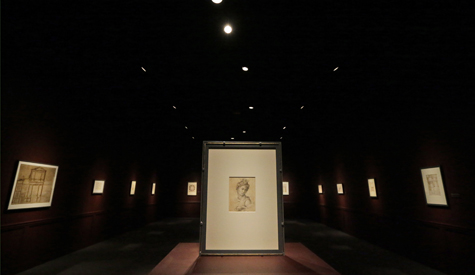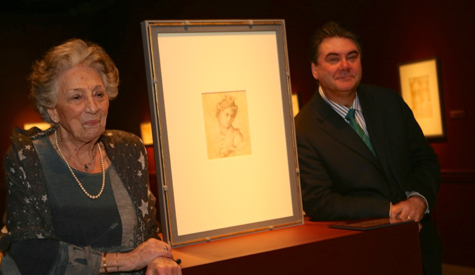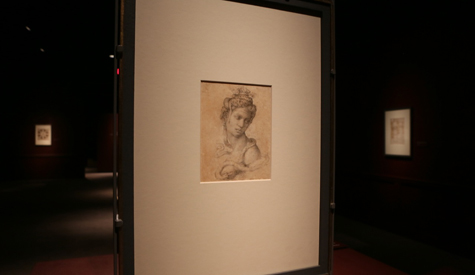Michelangelo drawings cast light on famed artist's dual life
Hanging on the palatial red walls on the second floor of the Muscarelle Museum of Art are some of Michelangelo’s most rare and precious drawings.
Sketches upon sketches glimmer under the subdued light creating a perfect straight line to the back corner of the room. Some are architectural designs of churches and military fortifications, while others proclaim Michelangelo’s love of human beauty. The drawings are quiet, yet intense and cast light on two sides of the famed artist’s thoughts, life and personality: the sacred and the profane.
These pieces are the latest high-profile works of art to be displayed at William & Mary’s Muscarelle Museum. The exhibition, Michelangelo: Sacred and Profane, Masterpiece Drawings from the Casa Buonarroti, honors the 30th anniversary of the founding of the museum in 1983. Twenty-five drawings preserved by Michelangelo’s descendants from the family home, the Casa Buonarroti in Florence, will be on view Feb. 9 – April 14. Some have never been seen before in the U.S., according to John T. Spike, curator and assistant director of the Muscarelle.
{{youtube:medium|eecEAdhvxFk, John T. Spike looks at a few images from the Michelangelo exhibition at the Muscarelle.}}
“This is a once in a lifetime opportunity, and William & Mary’s Muscarelle Museum is thrilled to celebrate our anniversary with this international Michelangelo exhibition,” said Aaron De Groft, director of the Muscarelle. “You couldn't go to Italy to see 25 Michelangelo drawings, let alone masterpiece drawings from the Casa Buonarroti, so these images are really priceless.”
Spike, an Italian Renaissance scholar, has devoted his career to studying Michelangelo’s art and life. He says the dichotomy in Michelangelo: Sacred and Profane is one of the building blocks of Western philosophy.
“Michelangelo’s drawings capture the sacred parts of life – such as the divine beauty of Madonna and Child, but he’s also showing us the darker side of mortality,” explained Spike. “The contrast and coincidence of these two basic elements fascinated Michelangelo, and we can follow his thinking in his drawings.”
One example of this dualistic tension is the double-sided portrait of history’s most notorious temptress, Cleopatra. On the front, Michelangelo portrays her as nearly divine. Twenty years ago, curators discovered a hidden drawing on the back of this famous portrait – a woman’s face hideously distorted on the centuries-old paper.
“It’s the same Cleopatra as some horrible wraith or banshee,” said Spike. “This terrifying drawing is to remind us that we mustn’t give in to the allure of sensuality.”
The landmark show came to fruition thanks to a long-standing relationship and friendship between William & Mary's Chancellor Professor Emeritus Miles Chappell with the Art & Art History Department and Pina Ragionieri, director of the Casa Buonarroti, said De Groft. Ragionieri worked with the Muscarelle a few years ago when the museum hosted "Michelangelo: Anatomy as Architecture, Drawings by the Master." It was then, said De Groft, that they began discussing a Michelangelo exhibition in 2013 to celebrate the museum's anniversary.
Like Leonardo da Vinci, Michelangelo was also called upon to invent fortifications. In the early 1500s, Florence came under attack from the Imperial army, which was backing the exiled Medici family. Michelangelo responded with drawings of defensive walls shaped like the segments of a giant crab, as shown in the exhibition’s Ground Plan of a Bastion for a City Gate.
The important ecclesiastical designs chosen for display in Michelangelo: Sacred and Profane include several plans too ambitious and costly to be realized: the facade of the church of San Lorenzo in Florence, the ground plan of the church of San Giovanni dei Fiorentini in Rome, and a new balustrade for the dome of the cathedral in Florence.
Several drawings are unfinished, said Spike, something Michelangelo repeatedly and intentionally did throughout his career.
“He left things unfinished to show us the limitations of our human ideas,” he explained.
Admission
During this exhibition, there is an admission fee of $15. Admission is free for Museum members, William & Mary faculty, staff and students, as well as children under 12.


















